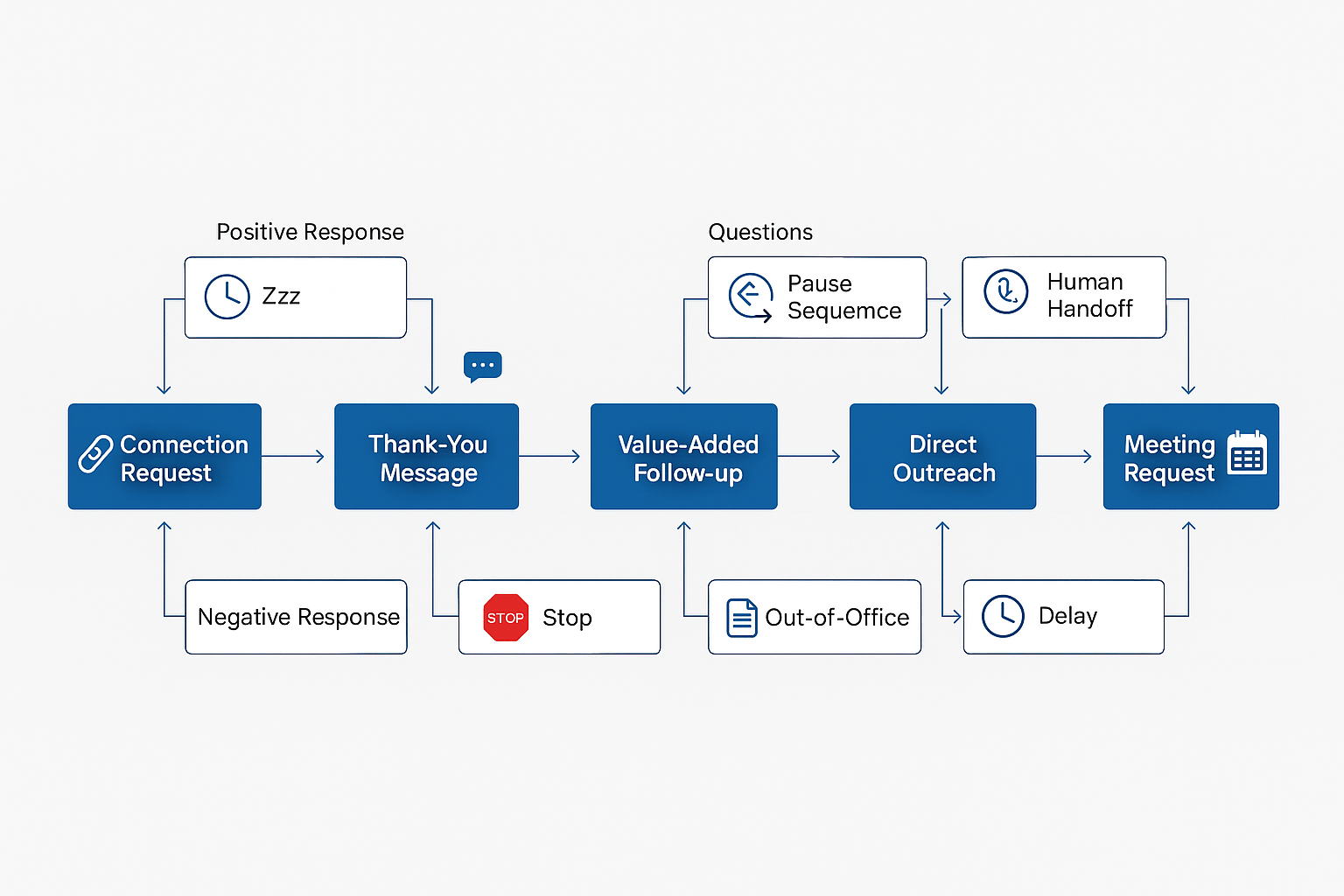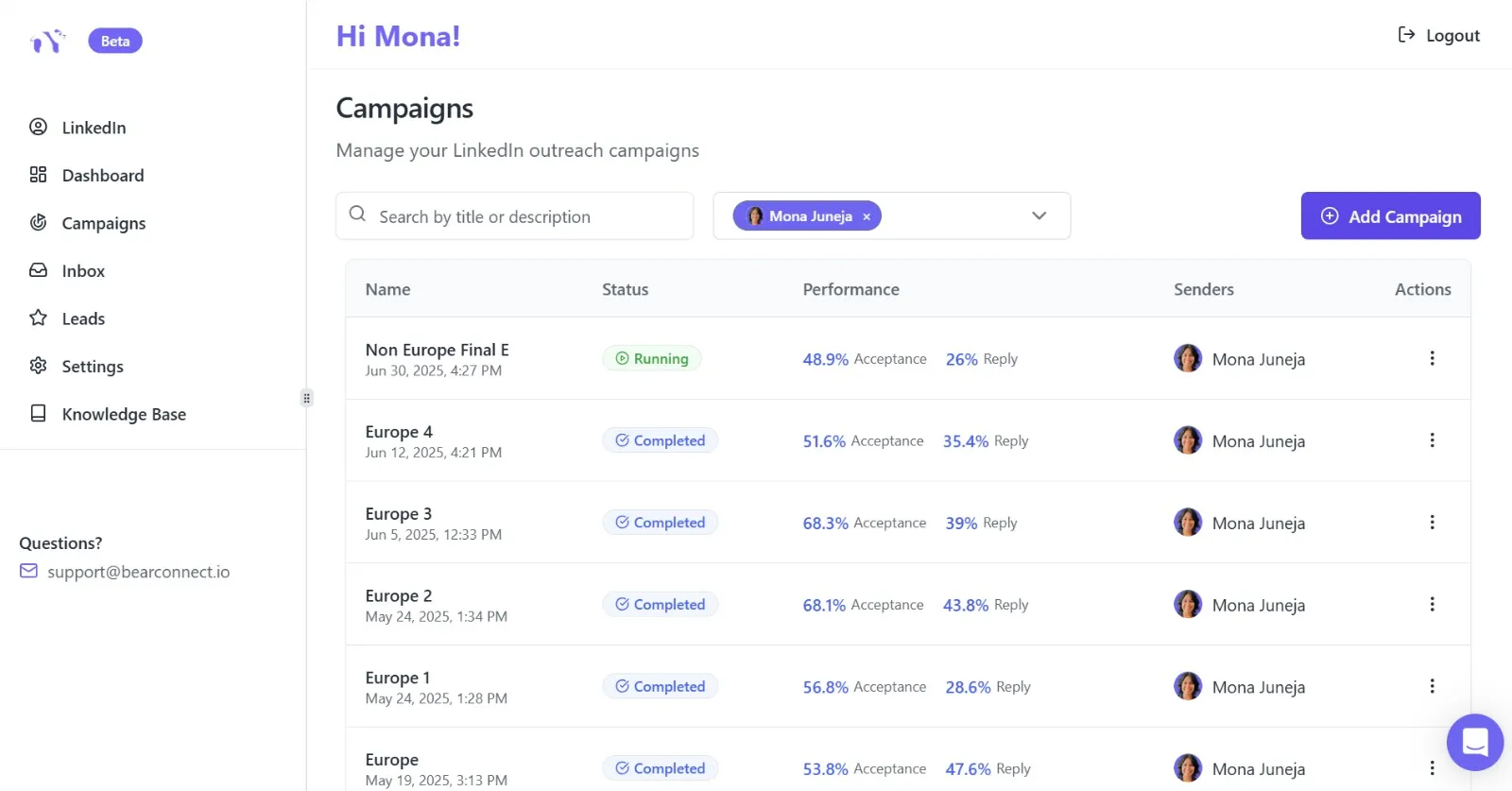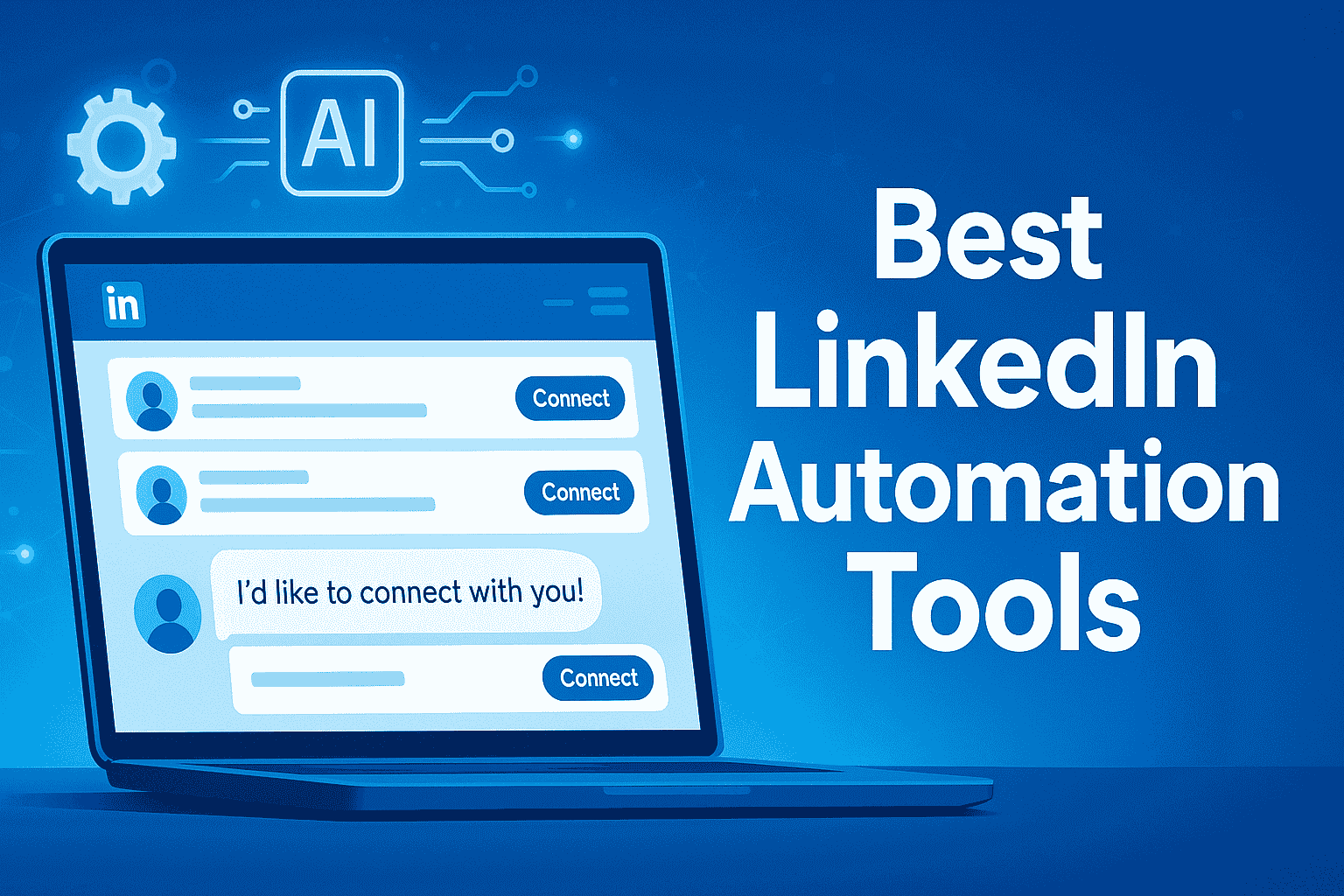How Does LinkedIn Automation Actually Work Behind the Scenes?

Ever wondered how top sales professionals manage to send 200+ personalized LinkedIn messages daily while still having time for calls and meetings?
The secret lies in understanding how LinkedIn automation actually works behind the scenes.
As a sales development representative, you've probably heard colleagues mention their "automation setup" or seen competitors seemingly everywhere on LinkedIn.
But what's really happening when you click "start campaign" on automation tools?
This deep dive reveals the technical processes that power modern LinkedIn automation, helping you understand not just what these tools do, but how they do it safely and effectively.
The Foundation: How LinkedIn Automation Mimics Human Behavior

- LinkedIn automation doesn't work like a simple bot firing off messages. Modern tools operate through sophisticated browser automation technology that simulates real human interactions.
- The goal is simple: make every automated action look exactly like something a human would do naturally.
1. The Browser Simulation Process
When you launch an automation campaign, the system creates what's called a "browser instance." This virtual browser opens LinkedIn just like you would manually.
Here's what happens step by step:
- The automation tool launches a Chrome-based browser session
- It logs into your LinkedIn account using your credentials
- The system navigates through LinkedIn pages at human-like speeds
- Each action includes realistic delays between clicks and scrolls
- Mouse movements follow natural patterns, not straight lines
This approach ensures LinkedIn's systems see normal user behavior rather than obvious automation patterns.
2. Smart Timing Algorithms
Professional automation platforms use advanced timing algorithms. Instead of sending messages every 30 seconds, they randomize intervals between 2-8 minutes.
The system also considers:
- Your historical activity patterns
- Peak engagement times for your industry
- LinkedIn's daily activity limits
- Time zone considerations for global outreach
This natural pacing mimics how real humans use LinkedIn throughout their workday.
The Data Processing Engine: How Automation Tools Find Your Perfect Prospects
- Behind every successful LinkedIn campaign lies sophisticated data processing. Understanding this helps you optimize your targeting for maximum results.
- Modern automation platforms don't just scrape LinkedIn profiles randomly. They use systematic filtering processes to identify high-quality prospects.
Lead Identification Technology
The filtering process works through multiple layers:
- Geographic filters target specific cities, states, or countries based on your ideal customer profile. This ensures your outreach reaches prospects in relevant markets.
- Industry classification uses LinkedIn's built-in industry tags plus keyword matching from company descriptions and user profiles.
- Job title analysis matches exact titles and related variations. The system recognizes that "VP Sales" and "Vice President of Sales" represent the same role.
- Company size indicators filter by employee count ranges, helping you focus on enterprises, mid-market, or startup prospects.
- Recent activity signals identify prospects who've updated profiles, changed jobs, or engaged with relevant content recently.
Tools like Bearconnect integrate with LinkedIn's search functionality to access these filtering options, dramatically improving prospect quality over random outreach.
Dynamic List Building
Once your filters are set, the automation system begins building your prospect list. This happens in real-time as the campaign runs.
The system continuously:
- Searches LinkedIn using your specified criteria
- Validates profile quality and completeness
- Checks for existing connections to avoid duplicates
- Updates lists as new matching profiles appear
This dynamic approach ensures your campaigns always target fresh, relevant prospects rather than stale contact lists from months ago.
The Technology Behind LinkedIn Automation

Understanding how automation tools actually function helps sales professionals make informed decisions about implementation and safety protocols.
Browser Simulation Technology
Modern automation platforms don't operate like simple bots firing off messages randomly. Instead, they use sophisticated browser automation that creates virtual sessions mimicking natural human behavior patterns.
The process involves several technical layers:
- Virtual browser instances - Tools launch Chrome-based sessions that appear identical to manual usage
- Human-like navigation - Systems move through LinkedIn pages at realistic speeds with natural delays
- Behavioral randomization - Actions include random mouse movements and authentic click patterns
- Session management - Platforms incorporate breaks, varying activity levels, and realistic usage patterns
This approach ensures LinkedIn's monitoring systems see normal user behavior rather than obvious automation signatures. The goal is creating indistinguishable activity that maintains account safety while delivering consistent results.
The Safety Infrastructure: How Automation Avoids Detection

- LinkedIn actively monitors for automation usage. Professional tools invest heavily in safety features to protect user accounts.
- Understanding these safety measures helps you appreciate why quality automation tools cost more than basic solutions.
Anti-Detection Technology
Modern automation platforms employ multiple layers of protection:
- Cloud-based infrastructure runs your campaigns from dedicated servers rather than your local computer. This provides more stable IP addresses and better performance.
- Behavioral randomization varies delays between all actions. Instead of clicking every button after exactly 3 seconds, the system randomizes timing between 2-8 seconds.
- Natural session patterns simulate realistic LinkedIn usage. The system includes breaks, inactive periods, and varying session lengths just like human users.
- Geographic consistency ensures your automation appears to come from your actual location rather than random data centers.
Tools like Bearconnect operate from cloud infrastructure specifically designed to mimic legitimate user behavior patterns.
Account Health Monitoring
Professional automation platforms continuously monitor your account for warning signs:
- Connection request acceptance rates indicate whether your outreach appears spammy. Low acceptance rates trigger automatic campaign adjustments.
- Message response rates show whether prospects find your messaging valuable. Declining responses suggest content optimization needs.
- Profile view reciprocation measures whether people visit your profile after you view theirs. This indicates genuine interest in your outreach.
- Account restriction notifications alert you immediately if LinkedIn flags any suspicious activity.
When metrics drop below safe thresholds, the system automatically adjusts campaign intensity or pauses activities entirely.
Compliance Frameworks
Leading automation tools maintain strict compliance protocols to protect your account:
Daily Limits Management:
- Connection requests: 15-25 per day maximum
- Messages to connections: 50-80 per day maximum
- Profile visits: 100-150 per day maximum
- Follow-up sequences: Spread across 3-7 day intervals
Content Guidelines:
- Spam keyword detection and avoidance
- Message quality requirements
- Automatic duplicate content prevention
- Professional tone verification
These limits ensure your automation stays within LinkedIn's acceptable usage policies.
Campaign Orchestration: Managing Multi-Touch Sequences

Effective LinkedIn outreach requires multiple touchpoints. Here's how automation platforms orchestrate complex campaign sequences.
Single-touch outreach rarely generates results. Most prospects need 3-5 touchpoints before responding to your message.
Sequence Logic Programming
Campaign sequences follow sophisticated logical flows:
- Initial Contact Phase begins with a connection request including a personalized message. The system waits 3-5 days for acceptance before proceeding.
- Acknowledgment Phase sends an automated thank-you message upon connection acceptance, then waits 2-3 days before continuing.
- Value-Added Follow-up shares industry-relevant content or insights based on the prospect's job function and company.
- Direct Outreach presents your value proposition with specific benefits for their situation.
- Meeting Request proposes a specific next step once engagement is established.
Bearconnect allows you to create these branching sequences that adapt based on prospect responses or lack thereof.
Response Detection and Routing
Modern automation tools can detect when prospects respond to your messages:
- Positive responses automatically pause the campaign sequence to prevent awkward follow-up messages after someone has already engaged.
- Questions get flagged for manual follow-up, ensuring human intervention when prospects show genuine interest.
- Negative responses remove contacts from all sequences immediately to respect their preferences.
- Out-of-office replies delay follow-up messaging until the prospect returns to work.
This intelligence prevents embarrassing automation mistakes while ensuring appropriate human follow-up when needed.
Analytics and Optimization: The Data Behind Successful Campaigns

LinkedIn automation generates massive amounts of performance data. Understanding how this information gets processed helps you optimize results.
The key is identifying which elements of your campaigns drive the best results.
Real-Time Performance Tracking
Professional automation platforms provide comprehensive analytics dashboards:
- Connection Metrics track daily connection requests sent, acceptance rates by industry and job title, time-to-acceptance averages, and geographic performance variations.
- Messaging Analytics measure open rates for initial outreach, response rates by message template, conversion rates to meetings or calls, and revenue attribution per campaign.
- Campaign Performance compares different sequences, identifies top-performing templates, and tracks cost per qualified lead generated.
- Engagement Patterns reveal optimal timing for different prospect segments and highest-response message combinations.
Performance Optimization Strategies
The data reveals specific optimization opportunities:
- Template Performance Analysis identifies which message variations generate higher response rates for different prospect types.
- Timing Optimization shows when different industries and job roles are most active on LinkedIn.
- Targeting Refinements reveal which prospect characteristics correlate with highest engagement and conversion rates.
- Sequence Adjustments indicate optimal spacing between touchpoints for maximum effectiveness.
Regular analysis of these metrics helps you continuously improve campaign performance over time.
ROI Calculation Frameworks
Professional automation tools provide detailed ROI analysis:
- Time Savings Metrics calculate hours saved versus manual outreach, typically showing 15-20 hours per week recovered for other activities.
- Cost Efficiency compares automation tool costs against the value of time saved and additional leads generated.
- Revenue Attribution tracks closed deals that originated from automated LinkedIn outreach campaigns.
- Lead Quality Assessment measures how automated leads compare to other prospecting channels in terms of conversion rates and deal size.
Security and Privacy: Protecting Your Data and Reputation
LinkedIn automation handles sensitive business data. Here's how professional platforms protect your information.
Data security becomes critical when automation tools access your LinkedIn account and prospect information.
Data Encryption Standards
Leading automation tools employ standard security practices:
- Secure data transmission protects information as it travels between your browser and automation servers.
- Account credential protection ensures your LinkedIn login information remains secure and encrypted.
- Contact data security safeguards prospect information collected during campaigns.
- Regular security updates maintain protection against emerging threats and vulnerabilities.
Privacy Compliance
Professional platforms maintain privacy standards:
- Data retention policies limit how long prospect information remains stored in automation systems.
- User consent tracking ensures compliance with privacy regulations in different geographic regions.
- Data minimization collects only necessary information for campaign execution.
- Secure deletion removes inactive account data according to specified schedules.
Bearconnect: A Real-World Example

Bearconnect exemplifies how modern LinkedIn automation platforms work in practice:
- Cloud-Based Infrastructure runs campaigns continuously without requiring your computer to remain active, providing consistent performance across time zones.
- Comprehensive Automation Features include connection request automation, follow-up sequence management, content scheduling for consistent visibility, and unified inbox management for all LinkedIn communications.
- Data Import Capabilities allow you to upload prospect lists via CSV files, LinkedIn search URLs, or Sales Navigator URLs for targeted campaigns.
- Analytics Dashboard tracks campaign performance, connection rates, response metrics, and ROI calculations in real-time.
- Safety-First Approach implements conservative daily limits, behavioral randomization, and account health monitoring to protect user accounts.
As a cloud-based platform launched in 2025, Bearconnect focuses on simplifying LinkedIn automation for sales teams and agencies without overwhelming users with complex features.
Implementation Best Practices for Sales Professionals
Understanding the technology helps you implement automation more effectively.
Success with LinkedIn automation requires strategic thinking beyond just turning on campaigns.
Campaign Setup Strategy
Start Conservative by beginning with 10-15 connection requests daily, using 2-3 message templates initially, focusing on narrow prospect segments, and monitoring acceptance rates closely.
Scale Systematically by increasing volumes based on performance metrics, adding new message templates gradually, expanding targeting criteria slowly, and maintaining quality over quantity focus.
Monitor Continuously through weekly performance reviews, monthly campaign audits, and ongoing optimization based on data insights.
Common Pitfalls and How to Avoid Them
Understanding how automation works reveals potential failure points you can prevent.
Most automation failures stem from unrealistic expectations or improper setup rather than technical limitations.
Over-Automation Warning Signs
- Volume Over Quality leads to low acceptance rates, spam complaints, and account restrictions. Focus on targeted, relevant outreach rather than maximum volume.
- Generic Messaging results in poor response rates and damaged reputation. Invest time in creating truly personalized templates.
- Ignoring Analytics prevents optimization and improvement. Review performance data weekly and adjust accordingly.
Getting Started: Your Next Steps
LinkedIn automation streamlines your outreach by removing repetitive work while keeping communication personal.
Focus on auditing your current process, defining success metrics, and choosing tools that match your goals to unlock faster, more consistent growth.
Frequently Asked Questions
1. Is LinkedIn automation safe in 2025?
Yes, when implemented properly with professional-grade tools and conservative practices. Based on managing 200+ client accounts, those using reputable platforms with built-in safety features report 95% fewer restrictions.
2. What are LinkedIn's current automation limits?
LinkedIn's 2025 limits include 10-15 daily connection requests for free accounts, 15-20 for premium users, with 100 weekly maximums. Messaging limits are 50-80 daily for free accounts, 80-100 for premium users.
3. How do I measure automation ROI?
Track connection acceptance rates (target 40-50%), message response rates (aim for 25-35%), and meeting conversion rates (goal 12-18%). Calculate time savings (typically 15-20 hours weekly) and cost per qualified lead reduction (usually 60-75% compared to manual methods).
4. Which automation platform should I choose?
Select platforms with cloud-based infrastructure, built-in safety limits, and strong customer support. Recommended options include Bearconnect ($57-67/month), Expandi ($99-159/month), and Dripify ($79-99/month).
Author bio:
Written by Mona Juneja, a B2B Sales Strategist with over 20+ years of sales experience at big names like Microsoft, Oracle, and DELL. I helped multiple Agencies streamline prospecting workflows, improve connection rates, and generate consistent sales-qualified leads through automation.
Ready to Transform Your LinkedIn Strategy?
Join thousands of professionals already using Bearconnect to automate their outreach and grow their network.
7-day free trial • Cancel anytime
Related Articles

How SaaS Founders Generate 50+ Qualified Leads Monthly with LinkedIn Automation
SaaS founders are now using LinkedIn automation to generate 50+ qualified leads every month. This guide shows how automated workflows, optimized outreach, and smart sequencing help you scale conversations, book more calls, and stay ahead of competitors still doing manual outreach.

Best LinkedIn automation tools for sending personalized connection requests
Struggling with low LinkedIn connection acceptance? This guide breaks down the best LinkedIn automation tools for sending safe, personalized requests that boost replies and save hours.

LinkedIn Message Templates for Automation that Get 3x More Replies
Boost your LinkedIn outreach with proven automation message templates that consistently get 3x more replies. Learn what actually works and why.